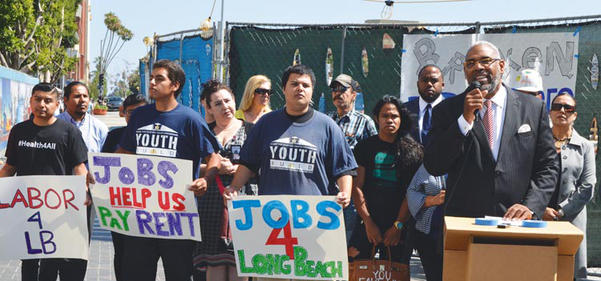On June 28, community groups held a press conference outside Long Beach City Hall calling out what they viewed as a broken promise on behalf of the city related to the local hiring provision of its project labor agreement (PLA) for certain municipal construction projects. The city contends it has met the local hiring provision of the PLA, which was passed by the Long Beach City Council in May 2015, and released data on the same day to illustrate its standing.

Darick Simpson, executive director of the Long Beach Community Action Partnership, speaks out at Long Beach City Hall about the city’s project labor agreement for construction projects, which he argues has not resulted in enough jobs for Long Beach residents. (Photograph by the Business Journal’s Larry Duncan)
The PLA requires contractors on certain city projects that cost more than $500,000 to hire through the Los Angeles/Orange Counties Building and Construction Trades Council. According to Long Beach Public Works Director Craig Beck, these include most vertical building projects.
“It does exclude some of the street work and utility work that we do, but it is pretty much anything you would build that goes above the ground that is above $500,000, unless the funding source we’re using precludes a PLA,” Beck said. Since the PLA was passed, 15 projects have fallen under the agreement.
Per the PLA, for all projects, 40% of workers must be hired locally. Additionally, 10% of all hired workers must qualify as disadvantaged or veterans.
According to both sides, the disagreement is more a matter of how “local hiring” was defined in the PLA. The agreement denotes that locally hired workers must be found within Los Angeles and Orange counties but also requires that eligible Long Beach workers must be selected first.
“The city council sold our community on the promise of a project labor agreement with job opportunities for local and disadvantaged Long Beach residents. And these are folks who need jobs the most,” James Suazo, communications manager for Building Healthy Communities: Long Beach (BHC), told the Business Journal. “We have been looking at the data. We know that two years later that promise still hasn’t come true.”
BHC is an organization with a number of affiliated nonprofit advocacy groups, including the Local Hire Coalition and the Long Beach Coalition for Good Jobs. Other groups involved in the press conference included the Long Beach Community Action Partnership, Women in Non-Traditional Employment Roles, Long Beach Residents Empowered, Filipino Migrant Center and others.
According to a statement from the City of Long Beach, Long Beach and Gateway Cities residents made up 41% of workers hired for the 15 projects executed so far under the PLA. Total local hires within L.A. and Orange counties represented 78% of all workers on the projects. Disadvantaged and veteran hires made up 14% of total workers.
One out of every five hours worked on PLA projects were performed by Long Beach residents, according to Craig Beck, director of public works.
For BHC and other community groups, this is not enough. “It was sold to the community that because it was city-funded construction jobs, that they would be jobs for Long Beach residents. And obviously again, with the numbers, we haven’t seen that,” Suazo said.
Beck explained that, per the agreement, contractors hiring for PLA projects must use labor from union groups within the Los Angeles/Orange Counties Building and Construction Trades Council. “They can either be a signatory to the building trades, which basically means that when they do work they are hiring only members of the trades, or if they have an individual that is a non-trade member, they have to pay a certain dues amount [to the union],” Beck explained.
If a contractor on a project wants to use their own non-union employees on a PLA project, they have to abide by what’s known as a one-for-one ratio. The first selected employee can be one of the contractor’s core employees, but the next must come out of the union hall, Beck said.
Union halls have work lists and go down these lists in order when assigning workers to projects. However, under the PLA, the signed unions must go out of order down their lists to ensure Long Beach workers are hired first, Beck explained. Long Beach employees are known as Tier 1 employees. Tier 2 employees under the PLA are Gateway Cities residents. Tier 3 is anyone within the two-county area.
Under the PLA, there is no required threshold to be met for Tier 1 or Tier 2 employees, according to Beck.
To be eligible to work on PLA projects, non-union workers would have to make a payment to the union involved during the time they are on the job, essentially granting them temporary membership, Beck explained.
City staff plans to bring a report to the city council to update them on the outcomes of the PLA in coming weeks, according to Beck. The agenda item originally passed by the council required staff to report back on an annual basis, but Beck explained it has taken until recently to amass enough information to have something to report on.
